What is Industry 4.0?
You may be hearing a lot of buzz about Industry 4.0 and wondering what all the noise is about. The concept arose from a project commissioned by the German government in 2011 through 2013. The term, which is sometimes written Industrie 4.0, refers to the fourth wave of the Industrial Revolution. Technologies leading to digital transformation include industrial automation and robotics; big data analytics; additive manufacturing; cloud computing; artificial intelligence; MES solutions; Nano technology; machine learning and digital twinning.
The Four Waves of The Industrial Revolution
- This change was driven by the widespread adoption of the steam engine which was used to power machinery and equipment in factories.
- The second wave was driven by the common availability of electricity, which helped to propel the move to mass production in factories.
- The third wave was driven by the adoption of computerized systems such as MRP/ERP for inventory planning and costing.
- The fourth wave, Industry 4.0, continues the digital transformation begun in the third wave, but its technologies represents a near complete recasting of manufacturing models with a factory floor focus.
The Impact of Industry 4.0
Connected devices that communicate about their status or service and maintenance requirements are everywhere. The Internet of Things now consists of many billions of connected devices, and every estimate of the future number of devices is quickly outpaced by the reality. Understanding the Internet of things for manufacturing whitepaper.
Cloud Computing
The cloud has enabled companies to adopt technology faster than they would have if they had to acquire and install new hardware and technology in house. Not only are business systems such as ERP available in the cloud, but Industry 4.0 infrastructure technologies such as IoT as a service and 3D printer farms for production are readily available. Learn more about factory floor solution in the cloud.
Additive Manufacturing
Additive manufacturing, the technical name for 3D printing, has reached the point where it is often competitive with traditional manufacturing for production quantities. New materials, including metals, biological materials and food, have allowed the variety of products that can be 3D printed to burgeon, and printers have increased in size to the point where they can effectively print modular housing.
Industrial Automation and Robotics
Machinery and equipment now reports production automatically to connected MES solutions, replenishes materials as required and notifies production supervisors or maintenance teams when the process approaches predefined quality parameter thresholds.
Robots create parts with an unprecedented degree of consistency, and they can perform operations safely in hazardous environments or conditions that are impossible for human workers.
As a result, scrap and rework—and the associated costs—are reduced dramatically, making products produced in digital factories more affordable and of higher quality than traditionally manufactured goods.
OEE (Overall Equipment Effectiveness) is another new and exciting way to measure your industrial automation performance. Learn more about the Myths and Mistakes surrounding OEE projects.
Big Data Analytics
Traditional ERP data collection is not equipped to capture or manage that volume of data, nor does the underlying data model have the finite gradients necessary for scheduling equipment down to the hour or minute. Companies are using purpose-built applications such as APS and MES to plan production and capture activity in Industry 4.0 factories. Take this quick evaluation and see if you can use a Proof-of-Concept for an APS Solution.
MES
An MES provides a user-friendly bridge between the complex technologies driving Industry 4.0 and the humans who must rely on the systems for insight.
An MES has an intuitive interface that allows factory floor personnel to easily interact with the system to provide real time feedback, using touch pads, alerts and real-time dashboards to keep the factory running at peak performance.
An MES delivers on the paperless ideal, and MES provides the data for calculation of important metrics such as OEE. Including a data historian and a SCADA system will increase the efficacy of MES in Industry 4.0 initiatives.
PWC research indicates that 33 percent of companies say they have already achieved an advanced level of automation qualifying as Industry 4.0. Fully 73 percent expect to achieve this ideal by 2020. It makes sense to start working toward digital transformation immediately, with a company and technologies that are ready to support the journey.
How are you doing with your factory floor performance? Take a quick evaluation and see.
Article as published on qad.com
